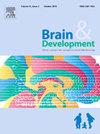由肌肉乙酰胆碱受体基因引起的先天性肌无力综合征的临床和遗传特征
IF 1.3
4区 医学
Q4 CLINICAL NEUROLOGY
引用次数: 0
摘要
目的肌肉成年烟碱乙酰胆碱受体是由四个跨膜亚基组成的五聚体复合体,分别由CHRNA1、CHRNB1、CHRND和CHRNE编码。由于CHRNA1、CHRNB1和CHRND引起的先天性肌无力综合征仅有少数病例报道。我们的目的是分享患者的表型和基因型特征。方法回顾性分析CHRNA1、CHRNB1、CHRND和CHRNE所致先天性肌无力综合征患者的临床特点、遗传变异、治疗及随访情况。此外,使用儿科生活质量量表3.0神经肌肉模块(PedQL™3.0 nmm)对护理人员进行问卷调查。结果14例患者入组。CHRNE变异最为普遍(42.9%),其次是CHRNA1变异(21.4%)、CHRND变异(21.4%)和CHRNB1变异(14.3%)。10例患者(71.4%)在出生时出现症状,其余4例患者(28.6%)在婴儿期出现症状。因CHRNA1、CHRNB1和CHRND引起的患者起病早(p = 0.01)。6例CHRNE变异患者的初始临床特征为上睑下垂。在CHRNA1、CHRNB1和CHRND变异的患者中,8例中有6例最常见的初始表现是进食困难。吡哆斯的明对12例(92.3%)患者有益。随后,10名患者试用了沙丁胺醇,只有两名患者因为不再有效果而停药。10例接受治疗的患者PedQL™3.0评分平均为76.50±11.66。结论所有患者均起病很早,多数有眼、肢、球症状。CHRNA1、CHRNB1和CHRND所致患者起病年龄早,首发症状较重。大多数患者在治疗中获得了一定的益处,生活质量调查结果令人满意。本文章由计算机程序翻译,如有差异,请以英文原文为准。
Clinical and genetic features of congenital myasthenic syndrome due to the muscle acetylcholine receptor genes
Objective
The adult nicotinic acetylcholine receptor in muscle is a pentameric complex composed of four transmembrane subunits, and these are encoded by CHRNA1, CHRNB1, CHRND, and CHRNE, respectively. There were only a few case reports of congenital myasthenic syndromes due to CHRNA1, CHRNB1, and CHRND. We aimed to share phenotypic and genotypic features of the patients.
Methods
The clinical features, genetic variants, treatment, and follow-up of congenital myasthenic syndromes patients due to CHRNA1, CHRNB1, CHRND and CHRNE were retrospectively reviewed. In addition, a questionnaire-based survey using pediatric quality of life inventory 3.0 neuromuscular module (PedQL™3.0NMM) was conducted on the caregivers.
Results
Fourteen patients were enrolled in this study. The variants in CHRNE were the most prevalent (42.9 %), followed by variants in CHRNA1(21.4 %), CHRND (21.4 %), and CHRNB1 (14.3 %), respectively. Symptoms presented at birth in 10 patients (71.4 %) and during infancy in the remaining four patients (28.6 %). The patients due to CHRNA1, CHRNB1, and CHRND had an earlier onset(p = 0.01). The initial clinical feature in 6 patients with CHRNE variants was ptosis. In the patients with CHRNA1, CHRNB1, and CHRND variants, the most common initial presentation was feeding difficulties in 6 of 8. Pyridostigmine was beneficial in 12 (92.3 %) patients. Salbutamol was then tried in 10 patients, and only two patients stopped it for no more effects. The mean score of PedQL™3.0 in 10 patients under therapy was 76.50 ± 11.66.
Conclusions
All patients had very early onset, and most had ocular, limb, and bulbar symptoms. The patients due to CHRNA1, CHRNB1, and CHRND had an early age at onset and more severe initial symptoms. Most of the patients got some benefit from therapy and had satisfactory results of the life quality survey.
求助全文
通过发布文献求助,成功后即可免费获取论文全文。
去求助
来源期刊

Brain & Development
医学-临床神经学
CiteScore
3.60
自引率
0.00%
发文量
153
审稿时长
50 days
期刊介绍:
Brain and Development (ISSN 0387-7604) is the Official Journal of the Japanese Society of Child Neurology, and is aimed to promote clinical child neurology and developmental neuroscience.
The journal is devoted to publishing Review Articles, Full Length Original Papers, Case Reports and Letters to the Editor in the field of Child Neurology and related sciences. Proceedings of meetings, and professional announcements will be published at the Editor''s discretion. Letters concerning articles published in Brain and Development and other relevant issues are also welcome.
 求助内容:
求助内容: 应助结果提醒方式:
应助结果提醒方式:


